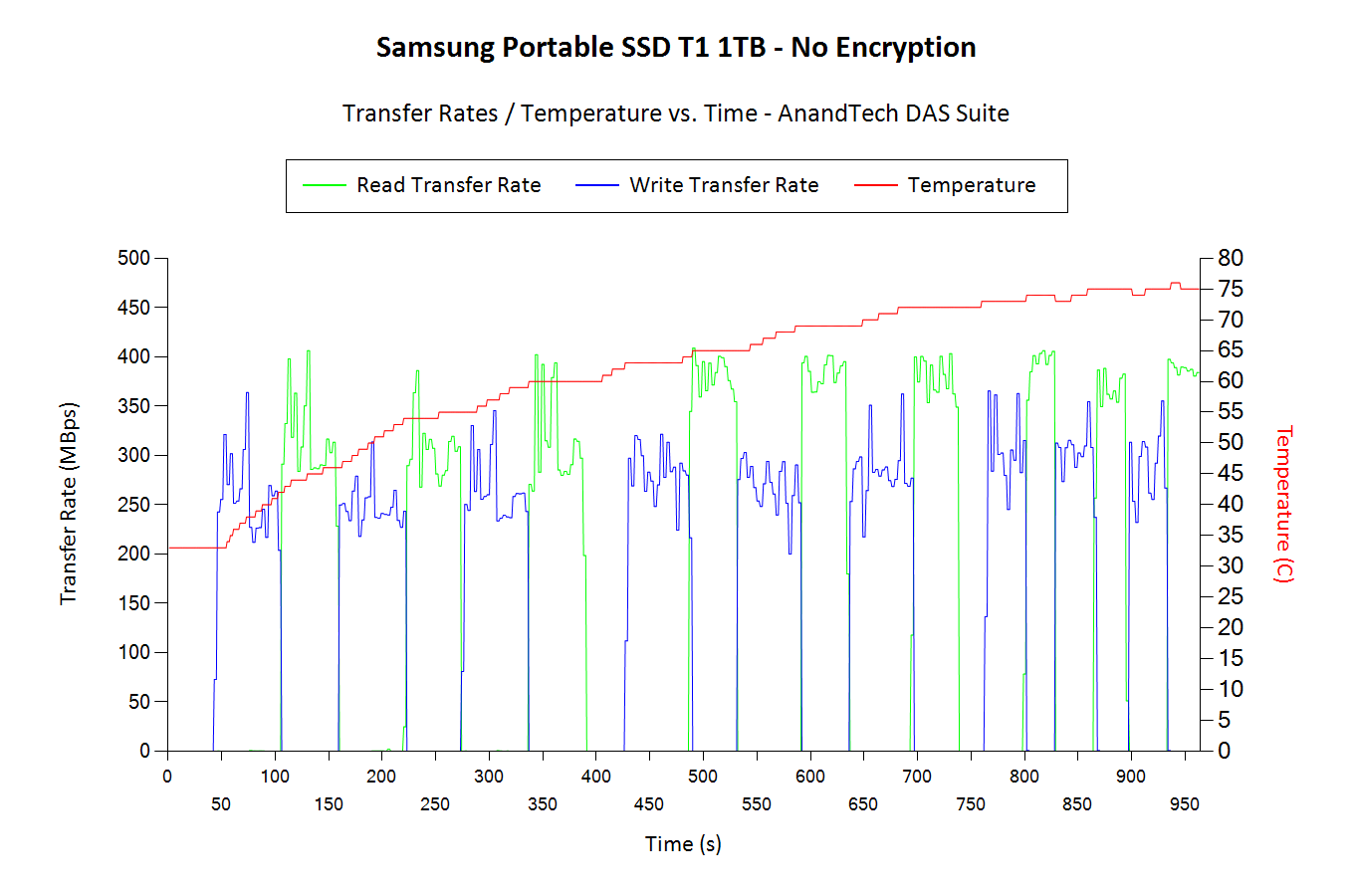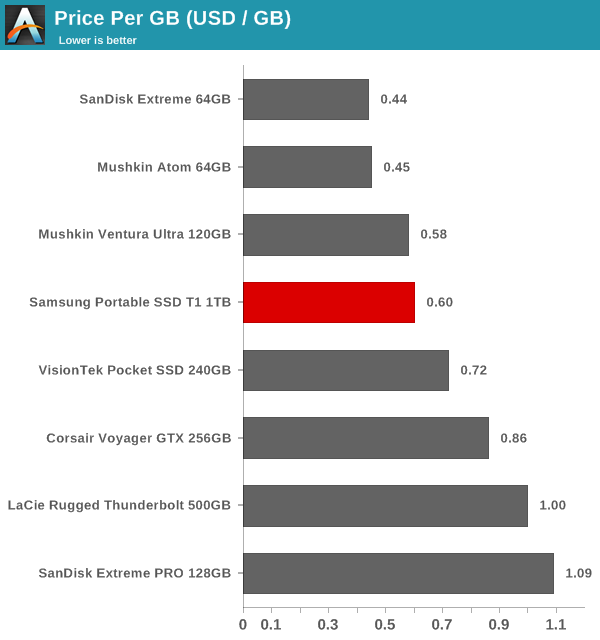Samsung Portable SSD T1 Review
by Ganesh T S on January 20, 2015 10:00 AM ESTPerformance Consistency and Concluding Remarks
Yet another interesting aspect of these types of units is performance consistency. Aspects that may influence this include thermal throttling and firmware caps on access rates to avoid overheating or other similar scenarios. This aspect is an important one, as the last thing that users want to see when copying over, say, 100 GB of data to the external portable SSD, is the transfer rate going to USB 2.0 speeds. In order to identify whether the drive under test suffers from this problem, we instrumented our robocopy DAS benchmark suite to record the flash drive's read and write transfer rates while the robocopy process took place in the background. For supported drives, we also recorded the internal temperature of the drive during the process. The graphs below show the speeds observed during our real-world DAS suite processing. The first three sets of writes and reads correspond to the photos suite. A small gap (for the transfer of the videos suite from the primary drive to the RAM drive) is followed by three sets for the next data set. Another small RAM-drive transfer gap is followed by three sets for the Blu-ray folder.
An important point to note here is that each of the first three blue and green areas correspond to 15.6 GB of writes and reads respectively. For the Samsung Portable SSD T1, we see throttling kick in only after more than 200 GB of data has been transferred continuously (the last two sets of reads in the graph below). The throttling seems to kick in after the drive temperature reaches 75 C. Another interesting aspect is the fact that the temperature rises a bit faster in the case where encryption is enabled.

A Note on TRIM
TRIM support would be really handy for a portable SSD. Usually, we don't see TRIM working over USB. However, the Corsair Voyager GTX with the Phison controller does support TRIM over the USB 3.0 interface. In addition, that drive also supports manual overprovisioning. The T1 has in-built overprovisioning, but manual control over it using the Samsung Magician software would also be nice. Of course, it is also arguable that TRIM and overprovisioning are not really needed for the T1's target market. However, for cases where the T1 is used as a portable OS drive (Windows-To-Go or some sort of portable Linux install), those features could improve user experience.
The internal platform of the T1 (the 850 EVO) does support TRIM. However, Samsung indicated that neither Microsoft nor Apple currently support issuing TRIM commands through the USB interface on their current OS. That said, they are exploring additional methods of forcing TRIM - including manually through the Samsung SSD Magician software. That feature will not be available in time for the launch, though.
Concluding Remarks
Coming to the business end of the review, the Portable SSD T1 brings Samsung to the forefront of external flash drive solution vendors. Keeping the flash fabrication, controller design and fabrication as well as the solution design in-house has enabled it to put out the most reasonably priced (if not, the only) 1TB external flash drive product in the market. The size and weight of the unit are both small enough to actually let the drive hang off the USB 3.0 port as a flash drive. That said, Samsung supplies a very short USB 3.0 cable - it is perfect for notebooks, but not so in the case of desktops with USB ports in the front or rear panels.
The performance of the drive leaves us with no doubt that it would be a great portable OS drive / Windows-to-Go solution, even though Samsung doesn't advertise it for that purpose. Unfortunately, Samsung has not decided to pursue the certification process. As far as non-enterprise consumers go, this is perfectly acceptable - the performance for Windows-to-Go is there without the extra cost associated with obtaining the certification that eventually gets passed on to them.
The only minor points of concern is the inability to recognize and take actions on the drive based on S.M.A.R.T features such as TRIM.

The 1TB 840 EVO mSATA SSD has been in the market for quite some time now. Hence, the size of the Portable SSD T1 didn't come as much of a surprise. From an end-user perspective, the size / capacity of the drive and the price point ($0.60/GB) are very attractive. The Portable SSD T1 makes for a compelling solution where fast transfers of large amounts of data is needed in a secure environment.










68 Comments
View All Comments
2kfire - Wednesday, January 21, 2015 - link
Also, I was comparing my laptop experience to yours, in that you were worried your drive was dead, whereas I don't give it a 2nd thought.The HDD bump story was a bonus ;)
Laststop311 - Wednesday, January 21, 2015 - link
This doesn't really make sense as a valid concern. If you need a drive to store data away but never have to access it so you are never connecting it to power for many years you wouldn't buy a pricey fast drive like this since speed is not important at all for data that is just going to be archived and not used. If you need reliable data retention in a pretty economic option just go with the 25GB m discs that use a rock layer to record data. Resistant to extreme light temp and humidity and lasts 1000 years.baii9 - Tuesday, January 20, 2015 - link
be wary that you may need a recent good USB 3.0 chip set with enough pcie lane to take advantage of the drive's adveristed speed. Some usb 3.0 saturated at 200-300MB/sbaii9 - Tuesday, January 20, 2015 - link
Some even stop at somewhere lower than 200.Laststop311 - Wednesday, January 21, 2015 - link
As long as you are using a native usb 3.0 lane directly off the chipset and not one off a controller you will have the full speed.baii9 - Wednesday, January 21, 2015 - link
ivy hasewell and broadwell only then, or sb on a ivy board+ amd~That's not alot of machine.
xilience - Tuesday, January 20, 2015 - link
Would it be possible to include a reference external HDD in these charts (and a reference HDD in all SSD charts) to compare to what 95% of people currently have? While the Samsung T1 seems to be twice the speed of, say, the Corsair GTX, it'd be nice to see just how much faster those options are versus a standard external HDD.akdj - Tuesday, January 20, 2015 - link
Black Magic, CrystalMark... & plenty of 'free/shareware' is easily located, downloaded and extremely light weight. You're welcome to run your own tests using the same benches the site uses. Some, like 64bit GeekBench support require a couple bucks but you don't 'need' it to measure the performance of yiur current rig. Plenty of similar or identical CPU and GPU matches to yours are available to compare on the different sites for benchmarksThese types of speeds on a 3.5" HDD would require drives in RAID, proper enclosure, 7200 RPM drives with 'power' and more than just a pair;). Even then I'm not sure you'd be able to achieve these speed at twice, even three times the cost...in dollars. In capacity, the winner is still obvious but the prices have dropped significantly in the past 24-36 months. And many vendors are switching. This size, a TB, with bus power is an absolute beast. And at twice the capacity of my Lacie Rugged TBolt 500GB SSD, it's a bargain.
Laststop311 - Wednesday, January 21, 2015 - link
There are tons of benchmarks for external hard drives easily found. You are lucky to even hit 100MB/sec reads off a regular HDD and it's usually below that for the mass majority of externals as they are usually 5400 rpm low power models.jasaero - Tuesday, January 20, 2015 - link
Is anyone making a more portable mSATA USB 3.0 enclosure? Or why not a 4 slot mSATA battery powered pocket NAS!! So many products one could do with these tiny flash memory formats and nobody is doing them.